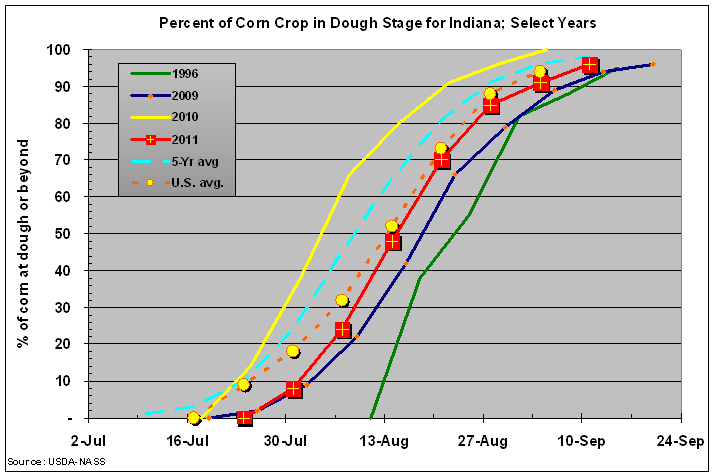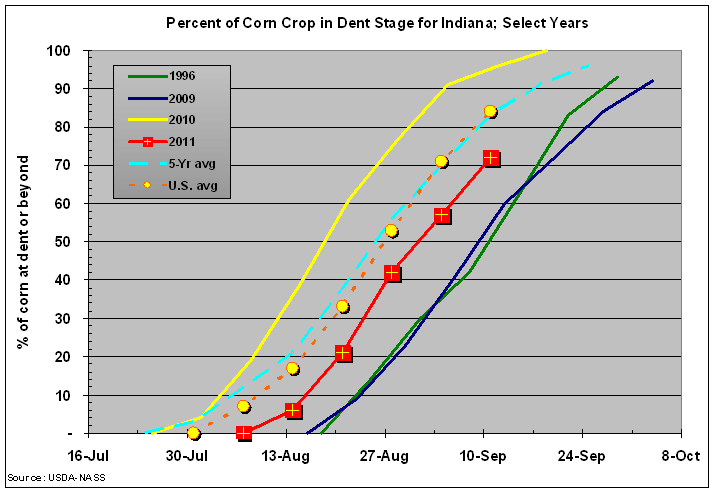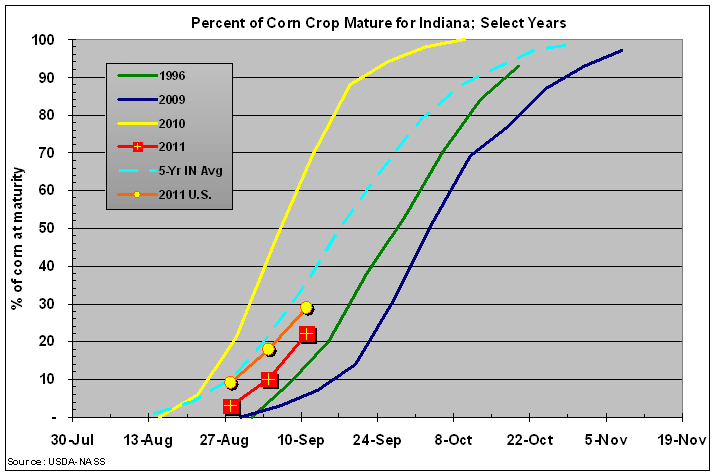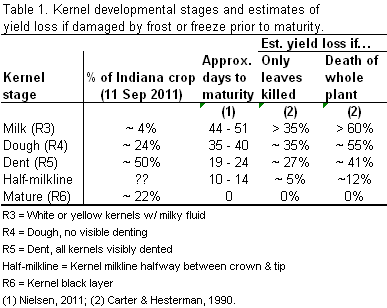
Fig. 1. Percentage of Indiana's corn crop at dough stage OR BEYOND; 11 Sep 2011.

Fig. 2. Percentage of Indiana's corn crop at dent stage OR BEYOND; 11 Sep 2011.

Fig. 3. Percentage of Indiana's corn crop safely mature; 11 Sep 2011.
12 Sep 2011
URL: http://www.kingcorn.org/news/articles.11/FrostRisk-0912.html
Delayed Corn Grain Maturity & Frost / Freeze Worries
R.L. (Bob) Nielsen
Agronomy Dept., Purdue Univ.
West Lafayette, IN 47907-2054
Email address: rnielsen
at purdue.edu
![]() ome forecasters are speculating on the risk of frost or freeze events later this week in the upper Midwest (Andresen, 12 Sep 2011; Dutcher, 9 Sep 2011). While these forecasts suggest the risk lies mainly in areas north of Indiana, growers with late-planted corn that is not yet mature remain concerned about whether their crops will mature before a serious frost or killing fall freeze.
ome forecasters are speculating on the risk of frost or freeze events later this week in the upper Midwest (Andresen, 12 Sep 2011; Dutcher, 9 Sep 2011). While these forecasts suggest the risk lies mainly in areas north of Indiana, growers with late-planted corn that is not yet mature remain concerned about whether their crops will mature before a serious frost or killing fall freeze.
Where does Indiana's corn crop stand at the moment relative to maturity and risk of frost / freeze injury to immature corn? The current USDA-NASS estimates of the kernel development progress of the 2011 Indiana corn crop (Sept 12 report) indicates that 96% of the crop is at the dough stage of development or beyond (Fig. 1), 72% of the crop is at the dent stage of development or beyond (Fig. 2), and only 22% of the crop is physiologically mature (Fig. 3).
Those numbers can be misleading because they represent the percentage of the crop at a given stage OR BEYOND. For example, when 72% of the crop is at the dent stage OR BEYOND and 22% of the crop is mature, then 50% of the crop is actually in the dent stage of development.
One needs to do similar "reverse" calculations to estimate the actual percentages of the crop that are at specific kernel stages of development. Doing so results in estimates that suggest approximately 4% of the state's corn crop remains in the milk stage of development, approximately 24% of the crop is in the dough stage, and about 50% of the crop is in the dent stage of kernel development.

An earlier article of mine offered some guidelines to help growers estimate maturity dates for corn based on current stages of kernel development (Nielsen, 2011). Those estimates are summarized in Table 1, along with estimates of possible yield losses if immature fields were damaged or killed by frost / freeze events (Carter & Hesterman, 1990). The difference between the estimates of yield losses in the last two columns of the table is based on whether the plant is completely killed or whether there is opportunity for surviving stalk tissue to remobilize stored carbohydrates to the immature grain before kernel black layer occurs.
Given the estimated percentage of the state's corn crop yet in the dent stage of development or younger, the significance of an early-occurring fall frost or freeze event in the next few weeks should not be underestimated.
Keep your fingers crossed!
Related reading
Carter, P.R. and O.B. Hesterman. 1990. Handling Corn Damaged by Autumn Frost (NCH-57). Purdue Extension. [online] http://www.ces.purdue.edu/extmedia/NCH/NCH-57.html [URL accessed Sep 2011].
Nielsen, RL (Bob). 2008. Grain Fill Stages in Corn. Corny News Network, Purdue Extension. [online] http://www.kingcorn.org/news/timeless/GrainFill.html [URL accessed Sep 2011].
Nielsen, RL (Bob). 2011. Predicting Corn Grain Maturity Dates for Delayed Plantings. Corny News Network, Purdue Extension. [online] http://www.kingcorn.org/news/timeless/RStagePrediction.html [URL accessed 12 Sep 2011].

